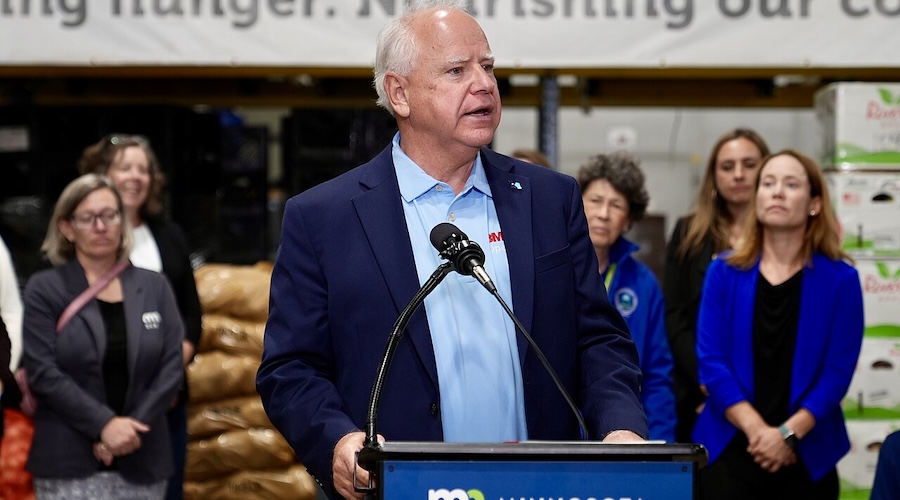
Repackaging the Immigration Propaganda of the 1990s
Commentary - Friday, June 20, 2025
By Jared Culver, Legal Analyst
Stephen Moore, a Senior Visiting Fellow at the Heritage Foundation, and Richard Vedder Senior Fellow at the Independent Institute, released a “new” report for an organization called “Unleash Prosperity” arguing for importing every cheap foreign worker possible to the United States. I use quotations around “new” because this is the exact same approach they have been advocating for decades.
The report opens by declaring, “Almost all economists would agree that throughout American history, immigration has been on balance a force for economic growth and higher living standards.”
Not one word of this sentence describes any reality or pins the authors down to defend anything concrete. It also completely ignores the post-World War Two era, when the United States had extremely low immigration and the largest growth of the middle class in our history.
If you look through the report, you will find the same old tropes about immigrants working harder than Americans, immigrants being smarter than Americans, and immigrants contributing more than Americans.
The authors even repeat the old debunked lie that immigrants do not take jobs from Americans, but rather create so much new demand for labor that they expand job opportunities and increase wages.
Here is the report in its own ridiculously absurd words:
“More workers would intuitively seem to mean more competition for jobs – especially at the lower end of the economic ladder. But this ignores the fact that the immigrant presence in America increases total income and output, and with that the demand for labor. In economist jargon, immigration increases both the demand for and the supply of labor.”
Yes, immigration is magically the only policy that has no downsides. There is no cost, only benefit according to “economist jargon.” And honestly, when has economist jargon ever steered anyone wrong?
If you believe that lie, then you’ll be comforted by this whopper:
Again, caution is warranted regarding causation. It has been demonstrated time and again, including by one of us, that immigrants move to regions with promising economic opportunities, namely those states where they are likely to earn high incomes. That is one of the economic virtues of immigrants: they go where the jobs are. But it is also true that a tripling or more in the proportion of the population that was foreign-born certainly did not depress incomes – if anything, given the high labor force involvement of immigrants, the opposite appears to be true.”
So immigrants raise American wages? That’s the pitch they are making? And almost all economists agree with this nonsense? Actually, no, most people do not believe that increasing labor competition also increases wages. That would mean the law of supply and demand does not apply to labor markets. Do “almost all” economists agree with that?
Remember when I said Moore was just repeating the same drivel in a “new” report? Check out this quote from Stephen Moore’s prepared remarks before the Judiciary Committee decades ago:
“Third, there is no evidence that immigrants lower wages or increase unemployment at the national level. Lowell Gallaway, Richard Vedder, and I did a study looking at the twentieth century, comparing periods of high immigration with unemployment and wages. And we found that there was no correlation between those two things.”
To be clear, with everything that has occurred with immigration over the last three decades, Moore and Richard Vedder haven’t changed their talking points one bit.
Compare this testimony from three decades ago:
“Next, there is no evidence that immigrants cause higher unemployment of minorities in cities. Now, this gets to a point that was made earlier about the fact that it is possible that the natives are moving out of cities with high immigration. The truth is actually just the opposite. And it is fairly obvious. If you look at, for example, states that are high immigration states, such as yours in Texas, Texas is a high immigration state, but there is also very large net domestic migration in states like California and states like Florida and states like Texas. So you are seeing immigrants and natives moving into the same areas, not immigrants chasing natives out of areas.”
Now look at the new “Unleashing Prosperity” report language:
“Let’s look at the four states containing a majority of American immigrants in 2023 – California, Texas, Florida, and New York. Note that from 2019 to 2023 continued high immigration was important in explaining Texas’s and Florida’s robust population growth, but the near absence of new immigration contributed to California’s and New York’s relatively stagnant population (actually falling in California). Were unemployment rates higher in the states with high continuing immigrant inflows, while lower in the others?
Figure 7 shows that high immigrant flows into Texas and Florida were associated with much lower unemployment than in California and New York. To be sure, other factors were at work explaining changing employment (including, for example, differences in income taxation), but the results make it very hard to believe the notion that “high immigration causes unemployment for native-born workers.”
So, in three decades, Moore and Vedder have parroted the same old canards about roughly the same States. They have not looked at new states or the developments in immigration over the past thirty years.
Check out this Stephen Moore quote from 1997 and compare it to his “new” report:
“In our 1997 Cato Institute-National Immigration Forum, [study] I identified ten high-tech firms founded by immigrants whose total revenues topped $28 billion in 1996 and whose total employment totaled more than 75,000 Americans. Immigrants have a higher rate of entrepreneurial activity than do natives.
Second, immigrants do not just take jobs, they create jobs through their purchases of goods and services. When immigrants purchase housing, groceries, computers, autos, VCRs, and the like, they are adding employment for American workers in these industries.
Third, immigrants add to the productivity of the American workforce. And all [note that three decades later it is only “almost all”] economists agree on two fundamental laws of labor economics. 1) Unemployment is a function of the wage rate; 2) the wage rate is a function of productivity. Immigrants could only be driving down average wage rates in the U.S. if they were driving down productivity. There is no evidence of that.”
Let’s focus for a second on this claim that wages are a function of productivity. Certainly, not all economists agree that wages are determined by productivity. That’s a laughably naive assertion by anyone claiming to be an economist. Wages are the product of negotiation, and negotiations are determined by myriad factors. Namely, the bargaining power of the sides involved will determine the wage of the employee. And bargaining power can be drastically undercut by flooding the labor market with competition.
Here is economist Paul Krugman in 2006:
“It’s intellectually dishonest to say, as President Bush does, that immigrants do “jobs that Americans will not do.” The willingness of Americans to do a job depends on how much that job pays—and the reason some jobs pay too little to attract native-born Americans is competition from poorly paid immigrants.”
The Congressional Budget Office (CBO), which scored the amnesty bill S.744 in 2013, had this to say about the impact on wages from flooding the labor market:
“CBO’s central estimates also show that average wages for the entire labor force would be 0.1 percent lower in 2023 and 0.5 percent higher in 2033 under the legislation than under current law. Average wages would be slightly lower than under current law through 2024, primarily because the amount of capital available to workers would not increase as rapidly as the number of workers and because the new workers would be less skilled and have lower wages, on average, than the labor force under current law.”
So, CBO found that wages would decline overall in the first decade and, through economic jargon, they would rise later on. We all know what to do when someone offers to lower your wages for a decade, but then promises belated increases in 10 years. However, the important point is, contra the “new” Moore report, wages are determined by supply and demand, not the naive notion of productivity.
Here is another example of the real impact of immigration on American wages from an LA Times article headlined Immigrants flooded California construction. Worker pay sank. Here’s why:
“In the span of a few decades, Los Angeles area construction went from an industry that was two-thirds white, and largely unionized, to one that is overwhelmingly Latino, mostly nonunion and heavily reliant on immigrants, according to a Los Angeles Times review of federal data.
At the same time, the job got less lucrative. American construction workers today make $5 an hour less than they did in the early 1970s, after adjusting for inflation.”
Also, recall the crippling inflation under the Biden Administration. Some economists recommended increasing immigration to reduce inflation because…you guessed it, the immigrants would apply downward pressure on wages:
“Economists, including those at the Federal Reserve, have identified persistent worker shortages, and more specifically immigrant worker shortages, as a major contributor to rising inflation. When labor is in short supply relative to demand, employers offer higher wages, which are in turn passed on to consumers, leading to rising prices. While these worker shortages have occurred for many reasons, a significant driver is the lower number of immigrants who have entered the U.S. in the past several years.”
Tight labor markets increase wages and employment opportunities for American workers and Moore, et. al., know it. Here is a Forbes article celebrating downward wage pressure caused by flooding immigrants into the labor force:
“Cortes used confidential microdata from the Consumer Price Index and estimated the impact of low-skilled immigration on consumer prices. “I find that, at current immigration levels, a 10 percent increase in the share of low‐skilled immigrants in the labor force decreases the price of immigrant‐intensive services, such as housekeeping and gardening, by 2 percent,” writes Cortes. She found wage impacts mostly fell on other immigrants. “Low-skilled natives and low-skilled immigrants are far from being perfect substitutes [in production] . . . therefore, a low-skilled immigration shock should affect mostly the wages of other low-skilled immigrants and have little effect on the wages of low-skilled natives.” Cortes found to the extent that there were adverse wage effects, they fell on “the wages of native Hispanics with low English proficiency than on the wages of other low-skilled native groups.”
To be fair to Moore and Vedder, since they obviously haven’t updated their thinking in three decades, they can’t be expected to answer the current discussions and topics. They are stuck in the 90s, where free trade would liberate China into a good faith partner, NAFTA would enrich the working class, and open borders would free American workers up to learn to code.
However, in the real world, the Unleashing Prosperity apologia for flooding the labor market is nakedly naive and out of touch with reality. This pathetic retread of failed arguments is remarkable only in its obstinacy. It is scary that many so-called respectable thinkers still feel free to peddle this nonsense without fear of contradiction by the compliant media that drinks from the same corporate trough as the propagandists for open borders.
With the current conflict regarding worksite enforcement raids, this type of report denying that downward wage pressures exist is designed to deny American workers their reality. It is attempting to tell policymakers that any stories of harmed constituents are anecdotal or racist. But American workers will consistently reject these absurdities for the same reason the authors spew them: economic interest.

Commentary - Massive Fraud Makes a Moratorium Necessary

Commentary - Automatic Birthright Citizenship on the Chopping Block

Video - Rosemary Jenks discusses the need for an immigration moratorium

Commentary - Immigration is Not a Foreign Policy Tool

Video - Rosemary Jenks joins OANN to discuss U.S. refugee policy and an immigration moratorium
